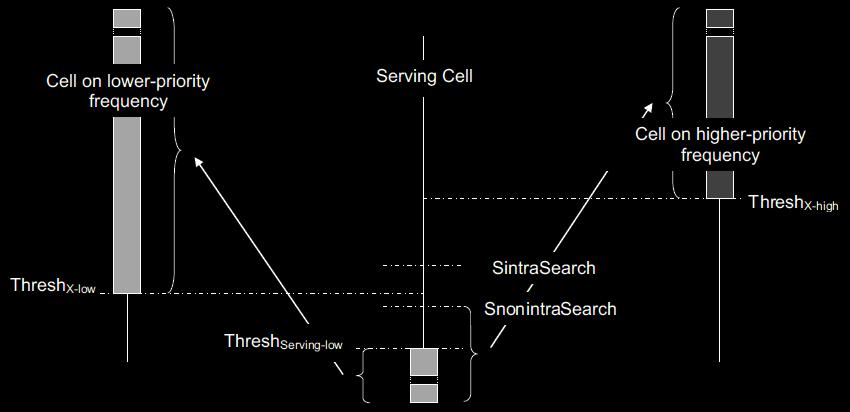E-UTRAN configures a priority for all applicable frequencies for each RAT. In addition to the priorities of specific cells that are optionally provided by SI, E-UTRAN can assign specific EU priorities through dedicated signaling. Since frequencies are indicated in the information system, the EU is expected to take into account only the cell reselection which has priority. Equal priorities are not applicable for inter-RAT cell reselection.
EU reselects to a cell in a frequency higher priority if the target cell S-criterion question exceeds a high threshold (ThreshX-high) for more than some Treselection. UE reselects from one cell to a lower frequency If the priority in which the criterion of serving cell is below a low threshold (threshold of service-Low), as the S-criteria of target cells at frequencies lower than the priority (possibly on another RAT) exceeds the a low threshold (ThreshX-low) the time interval Treselection, and at the same time, the cells in a higher priority frequency .UE be assessed based on the first threshold level or to the level of quality, depending on the parameters E-UTRAN configures. Figure illustrates the state (s) to be met again to select a cell on a higher priority frequency (gray bar) and in a cell at a frequency lower priority (dark gray bars).

If reselection frequency, possibly on different rat which has a different priority UE cell reselects the highest points on a given frequency. Please note that the thresholds and priorities set by the frequency and Treselection RAT installed.
Since Release 8, UMTS, and GERAN support a cell reselection priority basis, as shown in LTE, the frequency with priority. Issue 8 Release will continue to handle the traffic compensate EEC old. In addition, version 8 should UES applied based radio quality rating (offset), unless indicated support UMTS or GERAN priorities based reselection.
Frequency or RAT Evaluation for LTE UE
Frequency or RAT (Radio Access Technology) evaluation for LTE UE involves the process by which the user equipment (UE) determines the best available network access based on various factors like signal strength, quality, and network type. The UE scans different frequency bands and evaluates the signals from available LTE cells or other RATs (e.g., 3G, 2G) using parameters like RSRP (Reference Signal Received Power) and RSRQ (Reference Signal Received Quality). If the LTE signal is weak or unavailable, the UE may evaluate other RATs to find a suitable alternative for maintaining connectivity. This evaluation ensures that the UE connects to the optimal network based on its location and the available radio resources.